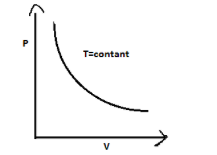
In the equation
A) Isothermal
B) Adiabatic
C) Isobaric
D) Irreversible.
Answer
495.3k+ views
Hint:Heat absorbed or given out by the system even though at every stage the gas has the same temperature as that of the surrounding reservoir. This is possible because of the infinitesimal difference in temperature between the system and the surrounding.
Complete step by step answer:
Given that,
The value of
Then above equation becomes,
The ideal gas equation for
As the temperature remains constant, along with mass of gas in this process.
That is
Then equation becomes,
This is the equation of the isothermal process.
A process in which a system undergoes physical changes in such a way that the temperature remains constant by the exchange of heat energy with the surrounding is known as isothermal process.
Additional information:
Consider a certain mass of a gas in a conducting cylinder fitted with a frictionless movable piston. The following conditions must be fulfilled to keep the temperature (for an isothermal process) constant.
-The cylinder and gas should be good conductors of heat.
-The cylinder should be in good thermal contact with surroundings.
-The surrounding should allow heat exchanges with the cylinder gas system keeping the temperature of gas essentially constant.
-The process should be quasi static.
-The process must be slow allowing sufficient time for the system to compensate for the changes, if any.

therefore Correct option is (A).
Note:In an isothermal process the internal energy remains constant.
For an ideal gas internal energy depends only on temperature. Thus, there is no change in the internal energy of an ideal gas in an isothermal process.
Complete step by step answer:
Given that,
The value of
Then above equation becomes,
The ideal gas equation for
As the temperature remains constant, along with mass of gas in this process.
That is
Then equation becomes,
This is the equation of the isothermal process.
A process in which a system undergoes physical changes in such a way that the temperature remains constant by the exchange of heat energy with the surrounding is known as isothermal process.
Additional information:
Consider a certain mass of a gas in a conducting cylinder fitted with a frictionless movable piston. The following conditions must be fulfilled to keep the temperature (for an isothermal process) constant.
-The cylinder and gas should be good conductors of heat.
-The cylinder should be in good thermal contact with surroundings.
-The surrounding should allow heat exchanges with the cylinder gas system keeping the temperature of gas essentially constant.
-The process should be quasi static.
-The process must be slow allowing sufficient time for the system to compensate for the changes, if any.

therefore Correct option is (A).
Note:In an isothermal process the internal energy remains constant.
For an ideal gas internal energy depends only on temperature. Thus, there is no change in the internal energy of an ideal gas in an isothermal process.
Latest Vedantu courses for you
Grade 6 | CBSE | SCHOOL | English
Vedantu 6 Pro Course (2025-26)
School Full course for CBSE students
₹45,300 per year
Recently Updated Pages
Master Class 9 General Knowledge: Engaging Questions & Answers for Success

Master Class 9 English: Engaging Questions & Answers for Success

Master Class 9 Science: Engaging Questions & Answers for Success

Master Class 9 Social Science: Engaging Questions & Answers for Success

Master Class 9 Maths: Engaging Questions & Answers for Success

Class 9 Question and Answer - Your Ultimate Solutions Guide

Trending doubts
State and prove Bernoullis theorem class 11 physics CBSE

Who built the Grand Trunk Road AChandragupta Maurya class 11 social science CBSE

1 ton equals to A 100 kg B 1000 kg C 10 kg D 10000 class 11 physics CBSE

State the laws of reflection of light

One Metric ton is equal to kg A 10000 B 1000 C 100 class 11 physics CBSE

Difference Between Prokaryotic Cells and Eukaryotic Cells




